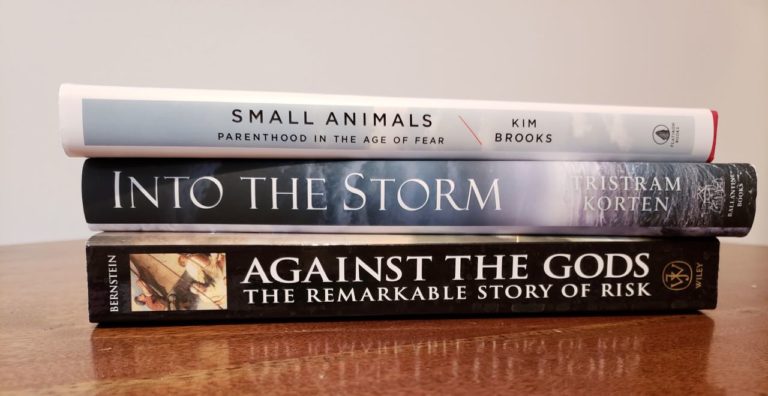For most of my career, when I’ve thought about risk it has involved specialized areas like sovereign credit risk, market risk, operational risk or political risk. But lately, I’ve been thinking a lot about how different “risk” in the financial sense is from the way people view risk in their day to day lives.
Peter Bernstein’s book Against the Gods: The Remarkable Story of Risk does a fantastic job describing the evolution of conceptions of risk throughout history. He tracks gambling from the ancient astragalus dice game played with the ankle bone of sheep or deer, through Asian card games and the more recent games of craps and poker. He follows the thinking of ancient Greeks and Talmudic scholars to Fibonacci’s thirteenth-century advances, to mathematical concepts of risk from the Renaissance through the nineteenth century. He delves into John Maynard Keynes’ framing of perceptions and judgments on estimates of probability; Nobel laureate Kenneth Arrow’s work on insurance and decisions under conditions of uncertainty; and applications of utility theory, game theory, chaos theory, and prospect theory. And he shows how the sweep of ideas over history have shaped modern financial markets.
The finance world still looks to Frank Knight’s classic technical definition, under which “risk” is quantifiable and insurable, where “uncertainty” is not. In markets, this view often leads to problems because all too often, risks that are set down on paper -in a credit rating, price or yield- rest on an illusion. Whoever assigns value does so based on certain combinations of fact and bias. All too often, their guesses are off the mark, as we saw during the 2008-09 financial crisis when many ratings agencies’ risk assessments turned out to be way off the mark.
Apart from the problems that come from an overly technical view of risk, the reality is that most of us think of risk and uncertainty as being closely intertwined. It’s a completely different conversation and concept from what takes place in the financial markets. The more retail investors there are in the market, the more dangerous this conceptual gap becomes.
In that light, insights from two recent books on risk in “real life” take on new meaning. One involves systemic failures to recognize risk, while the other calls out misguided efforts to reduce risks beyond a reasonable level. An added bonus is that both books happen to be great reads.
INTO THE STORM: Two Ships, a Deadly Hurricane, and an Epic Battle for Survival, my long-time friend Tristram Korten’s real-life account of two ships and Hurricane Joaquin. In researching this story, Tris interviewed scores of survivors, family members, experts and authorities, and pored through five hundred pages of devastating transcripts of conversations from one of the ships.
The sheer number of risk decisions that together determined the fates of the ships and their crews—policy choices like the Jones Act, inspection protocols weakened by industry lobbyists, the failure to upgrade safety equipment on aging ships (and the laws that made those decisions legal), which course to set weather data, protocol, and rescue strategy—boggles the mind. That’s even before mentioning the impact of climate change on the strength of storms, the economics of the shipping industry pushing ships past their life expectancies –giving new meaning to the term “rust bucket,” and delays in weather condition updates.
I don’t think it’s too much of a spoiler to share this description of one of the ships: “As the raft drifted away from the ship into the dark and vast sea, a thought too terrible began to creep into the sailors’ minds: If thousands of pounds of steel couldn’t protect them, what chance did they have with only a few millimeters of rubber and canvas separating them from the depths?”
A very different book, Kim Brooks’ SMALL ANIMALS: Parenthood in the Age of Fear is a sobering story and compelling analysis of what’s wrong with how Americans have come to view risk. She recounts the legal and emotional ordeal that ensued after she left her four-year-old son in a car in a parking lot for a few minutes on a day where he was in no danger from heat or cold, in a safe suburban community where she’d grown up — where parents when she was growing up could leave their kids in cars in safe weather without worrying about being arrested.
Brooks cites Centers for Disease Control numbers that statistically speaking, a child would have to be left alone in public for 750,000 years to be snatched by a stranger. Yes, you read that right.
Brooks illustrates several important points. First, that “the object of fear correlates less to the level of risk than to parents’ ability (or perceived ability) to exert control over the outcome.” Second, that risk assessment and fear of moral judgment are closely related. She cites research by the cognitive scientist Barbara Sarnecka showing that the higher people’s moral outrage at a parent’s reason for leaving, the more danger they are likely to estimate faces a child.
Brooks asks –then provides some compelling answers- what the cost is of fear-based policies that lead to cases like hers and what the effects are of their unequal impact on fathers and mothers, rich and poor.
With all the recent volatility in financial markets, it’s worth reflecting on the risk attitudes that drive investment decisions -and remembering that markets often behave more like the real world than most investment professionals would like to think.
#risk #ideas #books #systemsthinking #fear #uncertainty
- The Gray Rhino Wrangler on Substack - January 1, 2025
- Gray Rhino Risks and Responses to Watch in 2024 - January 10, 2024
- In the Media 2023 - December 31, 2023


